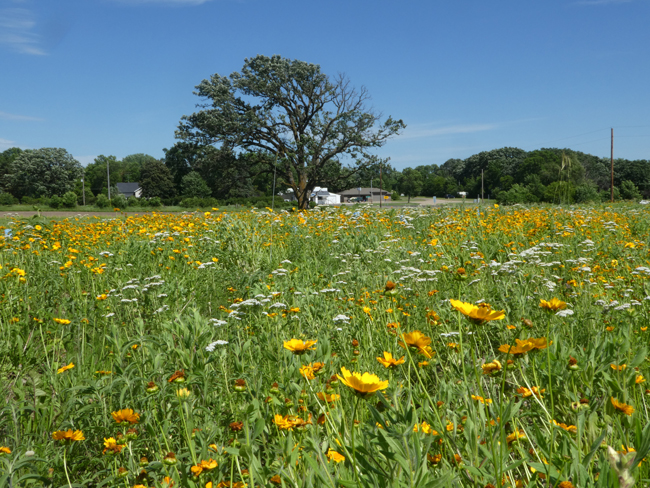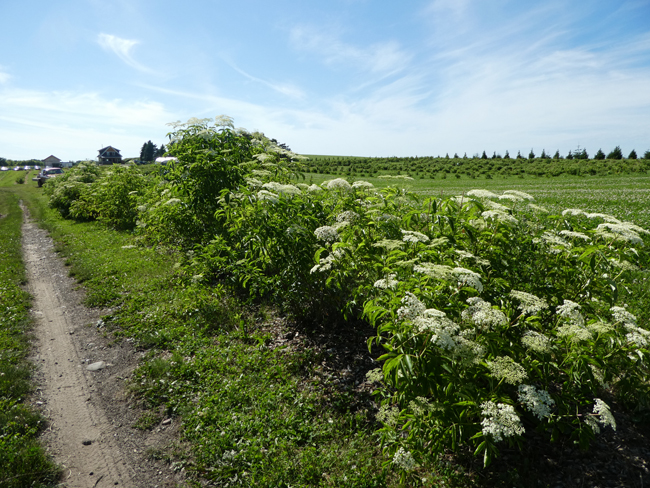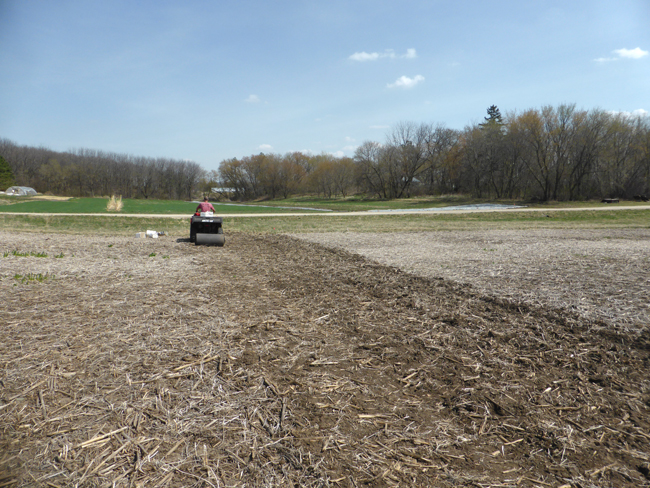This article originally appeared in our Spring 2017 issue of Wings – available here
“Prairie!” Just that one word in the subject line of an email from Erin, a Minnesota vegetable farmer with whom I am working, and I knew it was going to be a great message. The email itself was a series of photographs showing a glorious shock of yellow and white: the early summer blooms of a native wildflower meadow we had installed on Erin and Ben’s farm the spring prior. This email made my day because it was purely celebratory, at a time when my inbox was flooded with inquiries from farmers concerning weeds—how best to control them before seeding habitat, and how to deal with the big, bushy weeds so characteristic of areas of native planting in their first years of growth.
The year before, Erin’s planting had been no different from these, a “problem child” for sure—covered in dense crab grass, which, when mowed to control seed set, responded by simply setting seeds lower to the ground. Thankfully, the crab grass itself is a winter-killed annual, and all that new grass seed made little difference to the young planting the next year; our highly technical three-step approach—“mow, wait, and see”—had succeeded!
My work for the Xerces Society centers around creating and enhancing habitat for pollinators and other insects on farms in the Great Lakes region. This involves collaborating with farmers to prioritize conservation actions that best address the resource concerns and available space on their farms. For farmers growing such pollinator-dependent crops as apples or squash, there is strong interest in boosting populations of wild bees to ensure abundant fruit set.
A U-pick blueberry farm that I work with, Little Hill Berry Farm, is an excellent example of a crop management system that is highly dependent on bees for pollination. Many large-scale blueberry producers utilize managed honey bees to ensure that pollination needs are met. Native wild bees, however—such as mining, mason, and bumble bees—are well-known to be more effective than honey bees at pollinating blueberry flowers, and, when their habitat needs are met, can perform full pollination services. Unlike honey bees, which nest in boxes and may be carted onto the farm for a short period during bloom, native bees require a variety of nesting sites, as well as an ample supply of flowers for the duration of the growing season—before the blueberries bloom, and again long after the bloom is over.

In 2014, when I first visited Little Hill Berry Farm, we took some time to evaluate the existing habitat at the farm from the perspective of a pollinator. We found that although there were high-quality nesting areas for bees, food resources were often scarce during the entire length of the growing season. A few deciduous trees provided forage in particularly relevant for organic farmers, since they are typically using insecticides in a very limited way if at all, and are thus strongly reliant on having enough “good bugs” around to fight the “bad bugs.” Many wasps, hover flies, and other predator and parasitoid insects feed on floral resources during part of their lives, so by including the favored flowers of these creatures in our plantings, we can effectively increase natural pest control in adjacent crop fields—a research-supported strategy, and one for which several of the farmers I work with are already reporting positive effects.
For example, at Uproot Farm, a diversified vegetable operation where we have installed habitat, the owner recently noted that this year, for the first time since the farm’s establishment in 2009, she has not had to spray her spring kale and broccoli. Of course, lots of factors impact pest and predator cycles, but it is hard to believe that the flowers integrated directly into the brassica fields aren’t helping, especially after seeing these flowers covered in wasps, lightning bugs, and lady beetles during my summer visits.
Happily, native habitat can also be designed to provide edible and saleable resources for farmers. It is amazing to me how many under-used nutritional and medicinal native plants are available to us, if we can keep that traditional knowledge alive and also prevent these highly valuable plants from fading out of our landscapes. At Prairie Drifter Farm, another diversified vegetable operation in central Minnesota, the farmers have dedicated an area to native hedgerows specifically designed to provide food for both humans and pollinators, including such plants as elderberry, wild plum, juneberry, and New Jersey tea.

Here and elsewhere, we have been trying out a variety of methods of organic site-preparation for establishing wildflowers. Because conventional herbicides are often the go-to solution for preparing a site for planting, organic farmers may find themselves with limited options and minimal guidance. To address this, Xerces staff across the country have been conducting field trials testing the effectiveness of organic weed-removal techniques, including solarization, smother cropping, and even pig rooting.
Ensuring that habitat is as sheltered as possible from pesticide exposure is a key component of any pollinator habitat project, irrespective of the type of farm. We do this by placing habitat in the most protected areas, and by working with farmers to develop integrated pest management strategies for their crops in an attempt to minimize the overall usage of pesticides.
At all of the farms where we install habitat, we further engage the local community by hosting on-farm workshops, field tours, and work parties at various stages of the restoration process, including during the not-so-pretty early years of site preparation and regular mowing. At these events, we provide farmers and farm agency staff (principally from the Natural Resources Conservation Service and Soil and Water Conservation Districts) with technical information necessary to help their future habitat installations succeed. Hands-on activities, such as broadcasting wildflower seed, ensure that participants enjoy direct experience with at least one step of the restoration process.

These events have been highly successful at encouraging others to pursue similar conservation actions on their lands. For example, following one of our monarch-conservation field days last fall, sixteen farmers in the surrounding area reached out to initiate habitat planning. The majority of these had either attended the field day, or were recruited by agency staff in attendance—and we have already moved forward to get native habitat in the ground at a few of these farms. This ripple effect across communities not only increases quality habitat for pollinators, but also improves connectivity of that habitat across a landscape, while building stronger farmer-to-farmer support networks for conservation.
Across the Midwest, our plantings range from monarch meadows on dairy and row-crop farms, to beetle banks on vegetable farms, to a rather novel native understory planting currently becoming established as the ground cover for an apple orchard. Despite the practical benefits to crops resulting from this work, the most important factor in the motivation and long-term success of the habitat plantings is the genuine conservation ethic of the farmers we work with. These are farmers who view themselves as stewards of a piece of land for just a short period of its history, and they are committed to making that land better instead of worse for future generations. They recognize the practicality and joy of farming with nature, rather than against it. These are farmers who work harder and more skillfully than anyone I know, yet still find time to send celebratory emails about flowers, and to marvel at the buzzing of the bees.



